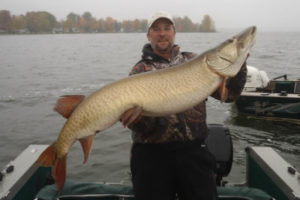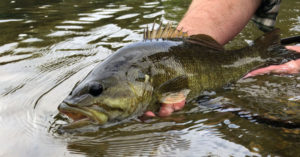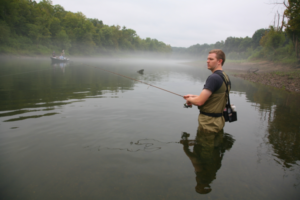Take a Fall Chautauqua to Lake Chautauqua
By Frank Sargeant, Editor
from the Fishing Wire

Catch muskie like this
For a relatively small lake, Chautauqua has an amazing number of huge muskies like this one, caught by anglers fishing with Muddy Creek Fishing Guides. (Photo Credit Muddy Creek Fishing Guides)
Upstate New York is an overlooked jewel when it comes to opportunities for fishing, hunting, hiking, camping and outdoors enjoyment, as I was reminded in a visit to Chautauqua Lake not long ago.
If “Chautauqua” sounds familiar, it’s because the idea of a summer getaway camp pretty much got its start here on the banks of the 20-mile long lake before spreading nationwide. The original was a sort of tent camp, church-linked but full of all sorts of diversions and entertainments that made it a huge draw for folks who couldn’t stand the noise and the heat of northeastern cities in summer.
These days, the original Chautauqua has grown into an upscale summer resort complex, still church-linked, but for outdoorsmen the lure of the lake and the creek, both also called Chautauqua, may be stronger than that of the camp.
Fall Steelhead
Chautauqua Creek connects to Lake Erie, and is a route for the steelhead that are stocked every year in “steelhead alley” by Ohio, Pennsylvania and New York. In late fall, steelies by the hundreds come up the creek. The typical fish averages 4 to 10 pounds and is 20 to 30 inches long—these are a long way from being small-stream brook trout. Some fish over 15 pounds also make the journey. In the narrow confines of the fast-flowing creek—it averages maybe 30 feet wide—they put up an amazing battle. (The original word “Chautauqua” meant “jumping fish” in Iroquois, now more appropriate for the creek than ever.)
While most Chautauqua Creek steelhead are in the 5 to 10 pound range, a few real slammers make the journey up the creek each year, as well. (Photo Credit Trout Unlimited)
The creek winds its way for about 15 miles, sometimes through a deep gorge, before emptying into Lake Erie, providing plenty of spots for walk-in fishing. It’s well worth the walk; the New York DEC reports the creek has one of the highest catch rates in the state for fall steelies. Catches of four or five fish per day per angler are not uncommon when the run is on. Here’s a state map showing open areas: https://www.dec.ny.gov/docs/fish_marine_pdf/chautauquacreek.pdf
Most anglers use medium-light spinning gear with 6- to 10-pound test mono, and fish salmon eggs in small nylon sacks, four or five eggs to a sack, suspended a couple feet under a small float. Some say the fish have color preferences on certain days—white, yellow and pink are among the favored colors. The fish can also be caught on flyrod streamers and nymphs—local shops have plenty of successful patterns.
One of the Nation’s Top Musky Lakes
Chautauqua Lake is noted as one of the nation’s top musky lakes. It’s about 8 miles south of the shore of Lake Erie and due east of the city of Erie, Pennsylvania. It’s a narrow lake about 20 miles long, with two distinct sections separated by a highway bridge.
The south end is relatively shallow, with an average depth of 10 to 15 feet; the north end above Bemus Point has plenty of water over 30 feet deep and holes to more than 70 feet. The lake is mostly fed by springs and rain so the water is clean, but there’s enough fertility to produce heavy weed growth—great fish habitat–along the shallows. In fact, many areas are too thick to fish near shore in late summer, but get out to the edge where the weeds fall away—a kayak, canoe or rental skiff will easily get you there–and you’ll find the fish waiting.
The lake is famed for big muskies, unusual in a fairly small lake, but the combination of abundant panfish and other forage and plenty of weed cover has continued to turn out big fish for many years. The lake is known not only for size—the lake record is a 54” fish that went 46 pounds—but also for numbers.
Anglers who know the water and the tactics regularly catch three or four muskies of 40 inches in a day, an unheard of score in most musky waters where one fish per week per boat is considered “hot” fishing. NY DEC keeps the action going by stocking some 13,000 muskies 8 to 10 inches long each year, and there’s also a one fish limit, with minimum size 40 inches. (Most musky anglers release their catch in any case—a musky is too valuable to catch only once, as they say.)
Most anglers troll or cast large wobbling plugs to connect with the giant muskies of Chautauqua Lake, though some also drift live baits. (Frank Sargeant Photo)
Trolling large wobblers is the favored tactic, but drifting big live baits also gets them, as does casting the weedbeds with large plugs. Needless to say, heavy gear is a must—most use stout baitcasters with 65-pound-test or heavier braid and a braided stainless steel leader to prevent cutoffs. The season is from the last Saturday in May to November 30.
Mike Sperry at Chautauqua Reel Outdoors in Lakewood, on the lake’s southwest shore, is an expert on catching the lake’s big muskies, and has one of the best selections of big musky lures you’ll ever find in a local tackle shop; www.chautauquareeloutdoors.com. Muddy Creek Fishing Guides is also among the well-known guide operations on the lake; www.mcfishinguides.com.
Bass and Walleyes
Chautauqua Lake also ranks among the top bass lakes in New York State according to NYDEC. It’s particularly loaded with largemouths due to the abundant weed cover.
All the usual bass tactics work, including fishing the weedlines and docks at dawn and dusk with topwaters. During the brighter hours, swimbaits, plastic worms and jigs on deeper scattered grass do the job.
The lake also has a good population of large smallmouth bass, particularly in the south basin—best bet for smallies is to fish live crawfish or minnows just off bottom on rocky points and other hard structure, though the fish move into the shallows and readily attack topwaters during the post-spawn. New York, like many northern states, has a closed season for bass. The open period is from the third Saturday in June through Nov. 30.
There’s a good fall bite of large walleyes, with most caught drifting with jigs or worm harnesses tipped with chubs or other minnows at depths of 25 to 40 feet. Walleyes are maybe the best eating fish in fresh water—the limit is five daily over 15 inches and the season stays open all summer, fall and winter, closing briefly in the spring spawn.
Where to Stay
Chautauqua Lake and Chautauqua Creek are small-town and agricultural country and there are not a lot of quality places to stay close by, but one that stands out is the year-old Chautauqua Harbor Hotel in Celoron.
Built in cooperation with the state’s Regional Economic Development Council and Chautauqua County on prime waterfront that had been vacant for some 40 years due to economic malaise in the area, part of the hotel’s mission is to bring jobs and prosperity to this less-developed area of the state.
The resort covers some 9 acres on the southeast end of the lake at Celoron. It’s got 1100 feet of shoreline, most fishable from shore, as well as a boat harbor, docks, open-air bar and a very nice restaurant.
The docks at Chautauqua Harbor, stretching some 1100 feet, provide lots of places to wet a line at dawn as well as to pull up a boat for lunch or dinner. (Photo Credit Chautauqua Harbor Hotel.)
They provide free coffee starting at 5 a.m., a big plus for anglers. Guide packages, including breakfast, are available through the hotel. They have indoor and outdoor pools for mom and the kids, a great fitness center and lots more; www.thechautauquaharborhotel.com.
A side trip to the National Comedy Center in Jamestown, N.Y.—childhood home of Lucille Ball—is just minutes away, and well worthwhile. Check out the tourism bureau for more; https://www.tourchautauqua.com. (Dave Barus is the resident fishing expert at the bureau and will be glad to steer you towards the hot bite.)


